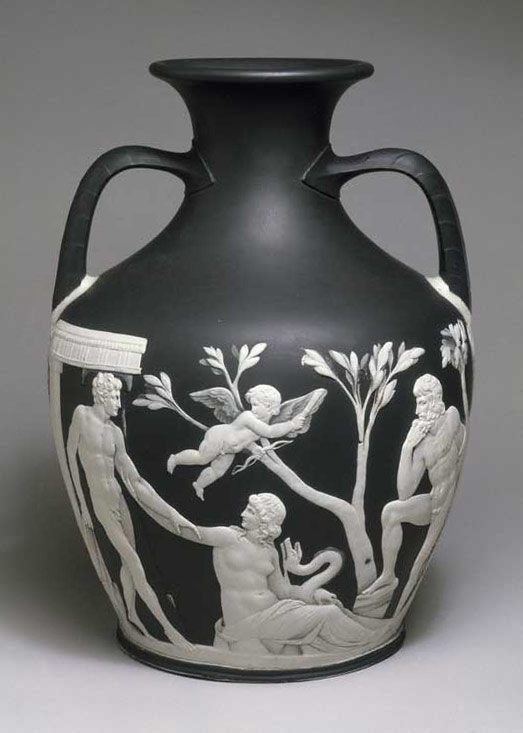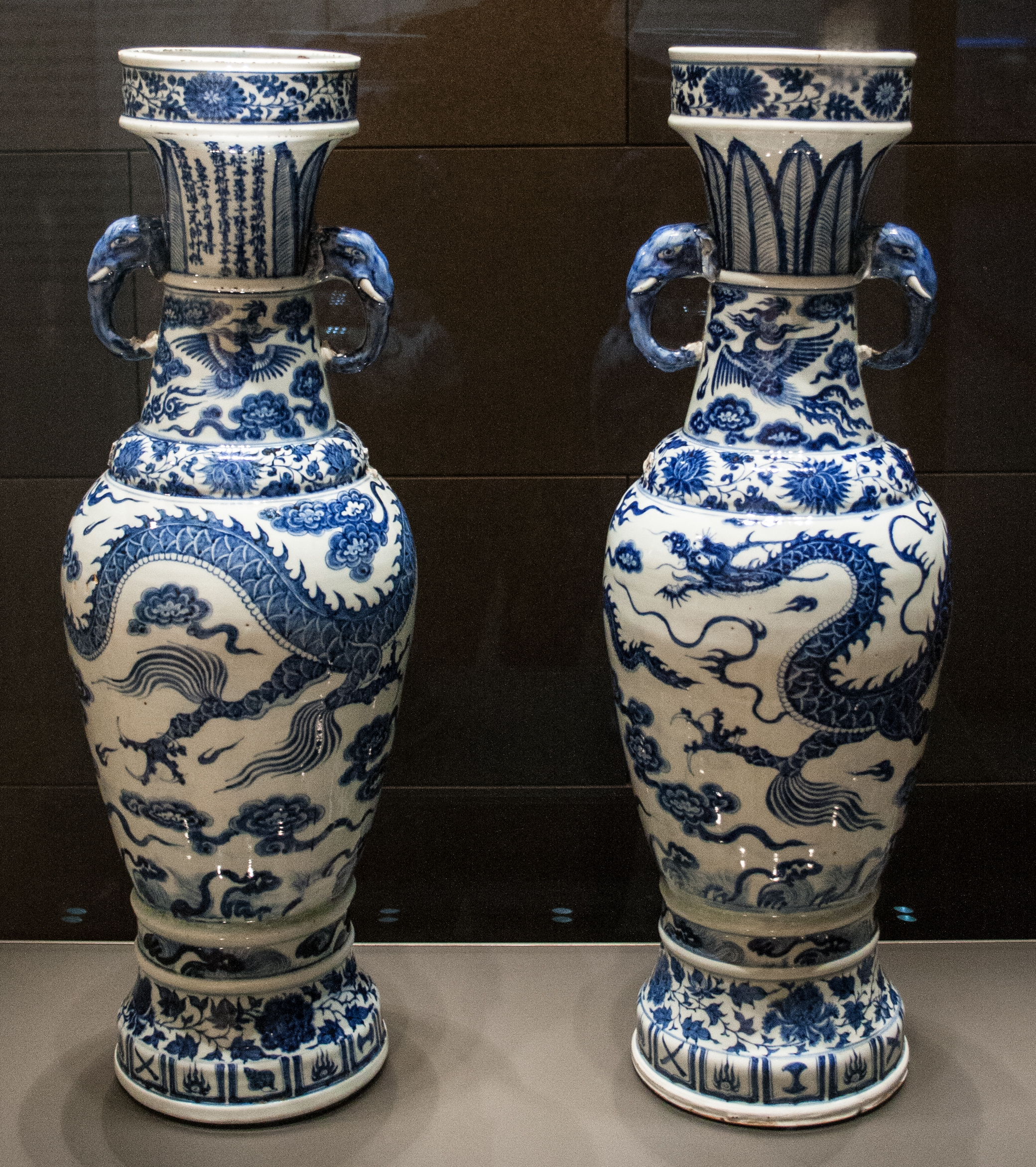Vase de cristal d'Aliﺣ۸nor.jpg on:
[Wikipedia]
[Google]
[Amazon]

 A vase ( or ) is an open container. It can be made from a number of materials, such as ceramics, glass, non- rusting metals, such as aluminium, brass,
A vase ( or ) is an open container. It can be made from a number of materials, such as ceramics, glass, non- rusting metals, such as aluminium, brass,
Terracotta lekanis (dish) MET DP114253.jpg, Detail of a red-figure lekanis; 365ﻗ350 BC; terracotta; Metropolitan Museum of Art (New York City)
Getty Villa - Mixing Vessel with a deceased youth - inv.96.AE.117.jpg, Red-figure mixing vessel; 330-320 BC; terracotta; from

 A vase ( or ) is an open container. It can be made from a number of materials, such as ceramics, glass, non- rusting metals, such as aluminium, brass,
A vase ( or ) is an open container. It can be made from a number of materials, such as ceramics, glass, non- rusting metals, such as aluminium, brass, bronze
Bronze is an alloy consisting primarily of copper, commonly with about 12ﻗ12.5% tin and often with the addition of other metals (including aluminium, manganese, nickel, or zinc) and sometimes non-metals, such as phosphorus, or metalloids such ...
, or stainless steel
Stainless steel is an alloy of iron that is resistant to rusting and corrosion. It contains at least 11% chromium and may contain elements such as carbon, other nonmetals and metals to obtain other desired properties. Stainless steel's corros ...
. Even wood has been used to make vases, either by using tree species that naturally resist rot
Rot(s) or rotting may refer to:
Decay Organic matter
* Rot, decomposition of organic matter
** Dry rot, of wood
** Root rot
** Wet rot, of wood
* Necrosis, of tissue
Technology
* Bit rot, data degradation
** Software rot, a form of bit rot
* Di ...
, such as teak, or by applying a protective coating to conventional wood or plastic. Vases are often decorated, and they are often used to hold cut flowers. Vases come in different sizes to support whatever flower it is holding or keeping in place.
Vases generally share a similar shape. The foot or the base may be bulbous, flat, carinate
Carinate is a shape in pottery, glassware and artistic design usually applied to amphorae or vases. The shape is defined by the joining of a rounded base to the sides of an inward sloping vessel. This design is seen in ancient cultures such as ...
, or another shape. The body forms the main portion of the piece. Some vases have a shoulder, where the body curves inward, a neck, which gives height, and a lip, where the vase flares back out at the top. Some vases are also given handles.
Various styles and types of vases have been developed around the world in different time periods, such as Chinese ceramics and Native American pottery. In the pottery of ancient Greece
Ancient Greek pottery, due to its relative durability, comprises a large part of the archaeological record of ancient Greece, and since there is so much of it (over 100,000 painted vases are recorded in the Corpus vasorum antiquorum), it has exe ...
"vase-painting" is the traditional term covering the famous fine painted pottery, often with many figures in scenes from Greek mythology. Such pieces may be referred to as vases regardless of their shape; most were in fact used for holding or serving liquids, and many would more naturally be called cups, jugs and so on. In 2003, Grayson Perry
Grayson Perry (born 1960) is an English contemporary artist, writer and broadcaster. He is known for his ceramic vases, tapestries, and cross-dressing, as well as his observations of the contemporary arts scene, and for dissecting British "pre ...
won the Turner Prize for his ceramics, typically in vase form.
History
There is a long history of the form and function of the vase in nearly all developed cultures, and often ceramic objects are the only artistic evidence left from vanished cultures. In the beginning stages of pottery, thecoiling
A coiling or coil is a curve, helix, or spiral used for storing rope or cable in compact and reliable yet easily attainable form. They are often discussed with knots.
Mountaineer's coil
The mountaineer's coil (also alpine coil, climber's coi ...
method of building was the most utilized technique to make pottery. The coiling method is the act of working the clay into long cylindrical strips that later become smooth walls.
Potter's wheel
The potter's wheel was probably invented in Mesopotamia by the 4th millennium BCE, but spread across nearly all Eurasia and much of Africa, though it remained unknown in the New World until the arrival ofEuropeans
Europeans are the focus of European ethnology, the field of anthropology related to the various ethnic groups that reside in the states of Europe. Groups may be defined by common genetic ancestry, common language, or both. Pan and Pfeil (2004) ...
. The earliest discovery of the origins of the potter's wheel was in southern Iraq. The discovery of this technique was beneficial to the people of south Iraq because it served as a substitute for their previous inefficient traditions. Upon this new technique, it would then grow gradually and even be adopted for the use of decorating pottery.
Garden vase
Garden vases are usually V-shaped but they can also becylindrical
A cylinder (from ) has traditionally been a three-dimensional solid, one of the most basic of curvilinear geometric shapes. In elementary geometry, it is considered a prism with a circle as its base.
A cylinder may also be defined as an infini ...
or bowl-shaped. They are usually made of ceramic or, today, plastic. Examples are the Torlonia Vase and the Medici Vase in the Uffizi Gallery in Florence.
Shapes
Gallery
Apulia
it, Pugliese
, population_note =
, population_blank1_title =
, population_blank1 =
, demographics_type1 =
, demographics1_footnotes =
, demographics1_title1 =
, demographics1_info1 =
, demographic ...
(south Italy); Getty Villa ( Los Angeles, USA)
Marble calyx-krater with reliefs of maidens and dancing maenads MET DT4541.jpg, Roman calyx krater
A krater or crater ( grc-gre, , ''kratﺥr'', literally "mixing vessel") was a large two-handled shape of vase in Ancient Greek pottery and metalwork, mostly used for the mixing of wine with water.
Form and function
At a Greek symposium, krat ...
with reliefs of maidens and dancing maenads; 1st century AD; Pentelic marble; height: 80.7 cm; Metropolitan Museum of Art
Codex-Style Vase with Mythological Scene MET DP-579-002.jpg, Maya codex-style vase with a mythological scene; 7thﻗ8th century; ceramic; height: 19 cm, diameter: 11.2 cm; Metropolitan Museum of Art
Two flasks with dragons.jpg, Two Chinese flasks with dragons; 1403-1424; underglaze blue porcelain; height (the left one): 47.8 cm, height (the right one): 44.6 cm; British Museum (London)
Vase MET DT3700.jpg, An example of Delftware; circa 1690; tin-glazed earthenware; height: 72.4 cm; Metropolitan Museum of Art
China, Jiangxi province, Jingdezhen, Qing dynasty (1644-1911), Qianlong mar - Vase with Three Rams' Heads - 1989.321 - Cleveland Museum of Art.tif, Chinese vase with three rams' heads; 1736-1795; cloisonnﺣ۸ enamel; diameter: 9.4 cm, overall: 14 cm; from Jingdezhen (Jiangxi province
Jiangxi (; ; formerly romanized as Kiangsi or Chianghsi) is a landlocked province in the east of the People's Republic of China. Its major cities include Nanchang and Jiujiang. Spanning from the banks of the Yangtze river in the north into hi ...
, China); Cleveland Museum of Art ( Cleveland, Ohio, USA)
Vase (one of a pair) MET DP214514.jpg, Rococo vase; circa 1761; soft paste porcelain; height: 24.1 cm; Metropolitan Museum of Art
Tuinvaas gedecoreerd met de Winter en de Lente Twee tuinvazen met de vier seizoenen, BK-16444-A.jpg, Garden vase decorated with summer and autumn; 1714; marble; height: 146 cm; Rijksmuseum
The Rijksmuseum () is the national museum of the Netherlands dedicated to Dutch arts and history and is located in Amsterdam. The museum is located at the Museum Square in the borough of Amsterdam South, close to the Van Gogh Museum, the St ...
( Amsterdam, the Netherlands)
Vase with cover (one of a pair) MET DP103165 (cropped).jpg, Neoclassical vases with covers; 1784-1795; soft-paste porcelain; height (with cover): 47.6 cm; made at the Real Fﺣ۰brica del Buen Retiro; Metropolitan Museum of Art
Vase with cover (vase des ﺣ۱ges) (one of a pair) MET DP-13079-025.jpg, French vase with cover (vase des ﺣ۱ges); 1788; soft-paste porcelain; height: 49.5 cm; Metropolitan Museum of Art
Gallﺣ۸ - Vase with clematis flowers.jpg, Art Nouveau
Art Nouveau (; ) is an international style of art, architecture, and applied art, especially the decorative arts. The style is known by different names in different languages: in German, in Italian, in Catalan, and also known as the Modern ...
vase with clematis flowers; by ﺣmile Gallﺣ۸
ﺣmile Gallﺣ۸ (8 May 1846 in Nancy – 23 September 1904 in Nancy) was a French artist and designer who worked in glass, and is considered to be one of the major innovators in the French Art Nouveau movement. He was noted for his designs of ...
; circa 1900; from Nancy; Budapest Museum of Applied Arts
The Museum of Applied Arts ( hu, Iparmﺧﺎvﺣ۸szeti Mﺣﭦzeum) is a museum in Budapest, Hungary. It is the third-oldest applied arts museum in the world.
Architecture
The museum was built between 1893 and 1896 and was designed by ﺣdﺣﭘn Lechner in t ...
( Budapest, Hungary)
Material types
* Glass * Ceramic * Crystal * Metal * Plastic * Porcelain * WoodSee also
* Ceramic art * Corning Museum of Glass * Pottery * UrnReferences
External links
{{Authority control Containers Vessels Decorative arts Pottery shapes